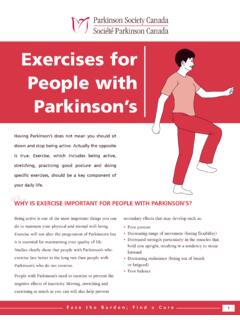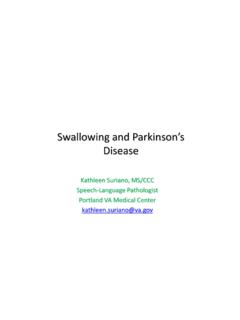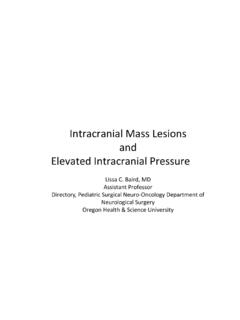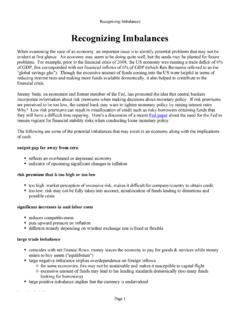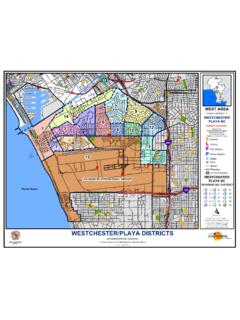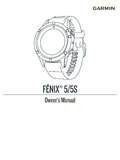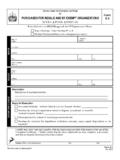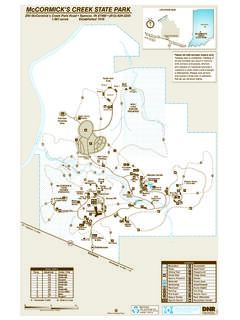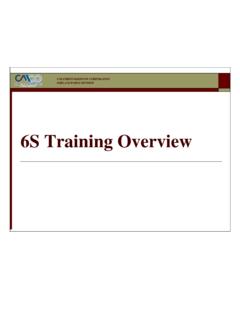Transcription of Swallowing and Parkinson’s Disease
1 Swallowing and parkinson s Disease Kathleen Suriano, MS/CCC Speech-Language Pathologist Portland VA Medical Center 2/8/13 NW PADRECC - parkinson 's Disease Research, Education & Clinical Center 1 OBJECTIVES: Discuss the role of Speech Pathology in the evaluation and treatment of parkinson s Disease . Obtain a general understanding of Swallowing function. Understand how Swallowing can be affected by parkinson s Disease . Learn basic strategies to cope with Swallowing issues. Current treatment and research Speech Pathology: Evaluation and Treatment Speech deficits: Imprecise articulation Accelerated rate Decreased intelligibility Voice/Respiratory Deficits: Limited vocal/pitch range Low voice and volumes Diminished respiratory support/coordination for voicing/speech.
2 Cognitive Deficits: Memory decline Diminished attention Difficulty with planning, abstract reasoning. Swallowing Deficits: Diminished oral control Changes in the pharyngeal stage Esophageal difficulties 2/8/13 NW PADRECC - parkinson 's Disease Research, Education & Clinical Center 2 DYSPHAGIA AND PD: parkinson s Disease Foundation: 1 million Americans live with parkinson s Disease . Approximately 60,000 individuals are diagnosed with parkinson s each year. This does not include the thousands that go undetected. An estimated 7-10 million individuals worldwide are living with parkinson s.
3 Incidence of parkinson s increases with age, but an estimated 4% are diagnosed before the age of 50. American Speech and Hearing Association: 33% to 50% of patients with parkinson s Disease have symptoms of dysphagia 90-100% show impaired Swallowing behaviors on objective studies ( , MBS or FEES) Severity and duration of PD does not predict presence or severity of dysphagia. MECHANICS OF Swallowing : FOUR PHASES OF Swallowing : Preparatory Phase Oral Phase Pharyngeal Phase Esophageal Phase *These four phases are dynamic and overlapping 2/8/13 NW PADRECC - parkinson 's Disease Research, Education & Clinical Center 3 NORMAL Swallowing : ORAL PHASE: Lips (CN VII) Buccal muscles (CN VII) Mastication (CN V) Tongue (CN IX, XII) Soft Palate (CN X) Faucial arches PHARYNGEAL PHASE.
4 Tongue (CN IX, XII) Soft Palate (CN X) Hyoid/Laryngeal elevation (CN V,IX,X,XII) Pharyngeal Peristalsis (CN IX) Vocal cords (CN X) Epiglottis Valleculae Pyriform Sinuses Cricopharyngeus (CN X, XII) ESOPHAGEAL PHASE: Cricopharyngeus (CN X, XII) Esophageal Peristalsis (CN X) CRANIAL NERVES: Trigeminal = CN V Facial = CN VII Glossopharyngeal = CN IX Vagus = CN X Accessory = CN XI Hypoglossal CN XII NORMAL Swallowing : (Liquid) 2/8/13 NW PADRECC - parkinson 's Disease Research, Education & Clinical Center 4 NORMAL Swallowing : (Pudding) NORMAL Swallowing : (Solid) 2/8/13 NW PADRECC - parkinson 's Disease Research, Education & Clinical Center 5 PREPARATORY PHASE: INCLUDES: Food preparation Hand to mouth Food is bitten off or taken from a utensil Liquids are sipped via cup or sucked through a straw DEFICITS NOTED WITH PD: Tremor Dyskinesias Increased food prep time ORAL PHASE: INCLUDES: Oral manipulation /mastication Bolus formation Bolus propulsion DEFICITS NOTED WITH PD.
5 Excessive manipulation time Lingual pumping Difficulty forming the bolus Difficulty throwing the bolus Oral residue post swallow 2/8/13 NW PADRECC - parkinson 's Disease Research, Education & Clinical Center 6 ORAL DYSPHAGIA: PHARYNGEAL PHASE: INCLUDES: Soft Palate elevates Tongue base makes contact with pharyngeal wall Hyolaryngeal excursion initiates Breathing momentarily stops Airway closes: Vocal cords close Epiglottis inverts Muscles of the pharynx contract Upper esophageal sphincter (UES) opens DEFICITS NOTED WITH PD: Bradykinesia / hypokinesia Pharyngeal delay difficulty triggering the swallow.
6 Laryngeal penetration material enters the top of the airway but does not drop below the vocal cords Aspiration material drops below the vocal cords into the lungs Silent Aspiration No cough is initiated Pharyngeal residue Material remains in the throat post swallow Decreased UES opening 2/8/13 NW PADRECC - parkinson 's Disease Research, Education & Clinical Center 7 Pharyngeal Dysphagia: (LIQUIDS) Pharyngeal Dysphagia: 2/8/13 NW PADRECC - parkinson 's Disease Research, Education & Clinical Center 8 ESOPHAGEAL PHASE: INCLUDES: Primary wave Esophageal clearance Lower esophageal sphincter relaxes *Persons with problems in the esophageal phase often have pharyngeal phase complaints.
7 DEFICITS NOTED WITH PD: Esophageal residue: Material does not clear through the esophagus into the stomach completely Retrograde flow: Material bounces back and forth within the esophagus Reflux: Material and stomach acids escape back up into the esophagus from the stomach. Diminished opening of the upper or lower esophageal sphincters NORMAL SWALLOW (Esophagus): 2/8/13 NW PADRECC - parkinson 's Disease Research, Education & Clinical Center 9 Esophageal Dysphagia: SIGNS AND SYMPTOMS: What to watch for ORAL PHASE DYSPHAGIA: Extra effort needed to chew/swallow Inability to eat specific foods/items Loss of food or liquid from the mouth Food sitting in the mouth after a meal PHARYNGEAL PHASE DYSPHAGIA.
8 Coughing, choking or gagging during or right after a meal Wet or gurgly voice or breath sounds after eating or drinking Sensation of food sticking in the throat ESOPHAGEAL PHASE DYSPHAGIA: Frequent episodes of regurgitation, reflux or spitting up after a meal Difficulty managing or clearing solid foods Sensation of food sticking in the throat or chest area Complaints of dysphagia without overt coughing or choking ASHA 2/8/13 NW PADRECC - parkinson 's Disease Research, Education & Clinical Center 10 , T; Bolser, D; et al., Voluntary Cough Production and Swallow Dysfunction in parkinson 's Disease .
9 , Dysphagia. (2008) 23;297-301. , AC., Rodrigues B., et al. Is Drooling secondary to a Swallowing Disorder in Patients with parkinson s Disease ?, Parkinsonism Relat Disord 2008; 14(3):243-245. OTHER POTENTIAL RISK FACTORS OR SIGNS: Recurrent pneumonias Diminished voluntary cough effort 1 Sialorrhea (excessive secretions/drooling)2 SPEECH PATHOLOGY EVALUATION: Clinical evaluation: Interview/history/background/medical status Oral Motor Exam Food/liquid trials Objective evaluation: Modified Barium Swallow (MBS) Flexible Endoscopic Evaluation of Swallowing (FEES) 2/8/13 NW PADRECC - parkinson 's Disease Research, Education & Clinical Center 11 FLEXIBLE ENDOSCOPIC EVALUATION OF Swallowing (FEES) TREATMENT OPTIONS.
10 Compensatory strategies Food/liquid texture modifications Behavioral/environmental manipulation Positioning Strengthening exercises Shaker Exercise - LSVT?? Masako - EMST?? Medical Management Botox/myotomy Medications Feeding Tube 2/8/13 NW PADRECC - parkinson 's Disease Research, Education & Clinical Center 12 QUALITY OF LIFE: Swallowing deficits have been linked to: Depression Sense of burden to family Reduced participation in social events Anxiety/panic What to do? Acknowledge changes in lifestyle Educate patients/families on all options Allow patients to make informed decisions Consider/offer assistance from mental health providers WHERE DO WE GO FROM HERE?


